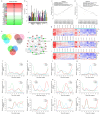Unveiling the molecular blueprint of SKP-SCs-mediated tissue engineering-enhanced neuroregeneration
- PMID: 39725969
- PMCID: PMC11670488
- DOI: 10.1186/s12951-024-03076-1
Unveiling the molecular blueprint of SKP-SCs-mediated tissue engineering-enhanced neuroregeneration
Abstract
Peripheral nerve injury poses a significant challenge to the nervous system's regenerative capacity. We previously described a novel approach to construct a chitosan/silk fibroin nerve graft with skin-derived precursor-induced Schwann cells (SKP-SCs). This graft has been shown to promote sciatic nerve regeneration and functional restoration to a level comparable to that achieved by autologous nerve grafts, as evidenced by behavioral, histological, and electrophysiological assessments. However, the underlying molecular mechanisms based on SKP-SCs mediated tissue engineering-aid regeneration remain elusive. In the present work, we systematically identified gene modules associated with the differentiation of SKPs into SCs by employing weighted gene co-expression network analysis (WGCNA). By integrating transcriptomic data from the regenerated nerve segment, we constructed a network that delineated the molecular signatures of TENG aid neuroregeneration. Subsequent quantitative PCR (qPCR) validation was performed to substantiate the WGCNA findings. Our WGCNA approach revealed a robust molecular landscape, highlighting hub genes pivotal for tissue engineering-aid regeneration. Notably, the upregulation of specific genes was observed to coincide with the acquisition of SC characteristics. The qPCR validation confirmed the expression patterns of these genes, underscoring their role in promoting neuroregeneration. The current study harnesses the power of WGCNA to elucidate the molecular blueprint governing tissue engineering-aid regeneration. The identified gene modules and validated targets offer novel insights into the cellular and molecular underpinnings of tissue engineering-augmented neuroregeneration. These findings pave the way for developing targeted therapeutics and advanced tissue engineering grafts to enhance peripheral nerve repair.
Keywords: Peripheral nerve regeneration; Schwann cells; Sciatic nerve injury; Skin-derived precursors; Tissue engineering; Weighted gene co-expression network analysis (WGCNA).
© 2024. The Author(s).
Conflict of interest statement
Declarations. Ethics approval and consent to participate: All studies complied with all relevant animal use guidelines and ethical regulations. All animal use and study protocols were approved both by the Institutional Animal Care and by the Administration Committee of Experimental Animals, Jiangsu Province, China, in accordance with the guidelines of the Institutional Animal Care and Use Committee, Nantong University, China (Inspection No: 20190225-004). Consent for publication: Not applicable. Competing interests: The authors declare no competing interests.
Figures







Similar articles
-
Skin derived precursor Schwann cell-generated acellular matrix modified chitosan/silk scaffolds for bridging rat sciatic nerve gap.Neurosci Res. 2018 Oct;135:21-31. doi: 10.1016/j.neures.2017.12.007. Epub 2017 Dec 27. Neurosci Res. 2018. PMID: 29288689
-
Skin derived precursors induced Schwann cells mediated tissue engineering-aided neuroregeneration across sciatic nerve defect.Bioact Mater. 2023 Dec 10;33:572-590. doi: 10.1016/j.bioactmat.2023.11.016. eCollection 2024 Mar. Bioact Mater. 2023. PMID: 38111651 Free PMC article.
-
Bone marrow-derived neural crest precursors improve nerve defect repair partially through secreted trophic factors.Stem Cell Res Ther. 2019 Dec 18;10(1):397. doi: 10.1186/s13287-019-1517-1. Stem Cell Res Ther. 2019. PMID: 31852510 Free PMC article.
-
Adipose tissue stem cells in peripheral nerve regeneration-In vitro and in vivo.J Neurosci Res. 2021 Feb;99(2):545-560. doi: 10.1002/jnr.24738. Epub 2020 Oct 18. J Neurosci Res. 2021. PMID: 33070351 Review.
-
Molecular and cellular mechanisms underlying peripheral nerve injury-induced cellular ecological shifts: Implications for neuroregeneration.IBRO Neurosci Rep. 2024 Dec 28;18:120-129. doi: 10.1016/j.ibneur.2024.12.013. eCollection 2025 Jun. IBRO Neurosci Rep. 2024. PMID: 39877591 Free PMC article. Review.
Cited by
-
Potentially commercializable nerve guidance conduits for peripheral nerve injury: Past, present, and future.Mater Today Bio. 2025 Feb 5;31:101503. doi: 10.1016/j.mtbio.2025.101503. eCollection 2025 Apr. Mater Today Bio. 2025. PMID: 40018056 Free PMC article. Review.
References
-
- Wang S, Lu H, Kang X, Wang Z, Yan S, Zhang X, Shi X. Electroconductive and Immunomodulatory Natural polymer-based hydrogel bandages designed for peripheral nerve regeneration. Adv Funct Mater. 2024;34:2310903.
-
- Zhou W, Rahman MSU, Sun C, Li S, Zhang N, Chen H, Han CC, Xu S, Liu Y. Perspectives on the Novel multifunctional nerve Guidance conduits: from specific regenerative procedures to motor function rebuilding. Adv Mater. 2024;36:2307805. - PubMed
-
- Haider A, Khan S, Iqbal DN, Khan SU, Haider S, Mohammad K, Mustfa G, Rizwan M, Haider A. Chitosan as a tool for tissue engineering and rehabilitation: recent developments and future perspectives – A review. Int J Biol Macromol. 2024;278:134172. - PubMed
MeSH terms
Substances
Grants and funding
- YJXYY202204, YJXYY202204-ZD04/Jiangsu Provincial Research Hospital
- CXZX202212/Jiangsu Provincial Key Medical Center, Jiangsu Provincial Medical Innovation Center
- ZDXK202240/Jiangsu Provincial Medical Key Discipline
- 2022YFC2409800, 2022YFC2409802/National Key R&D Program of China
- Grant No. 82172104/National Natural Science Foundation of China
LinkOut - more resources
Full Text Sources

